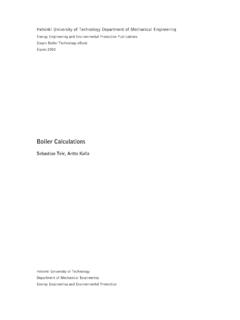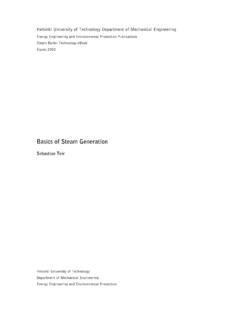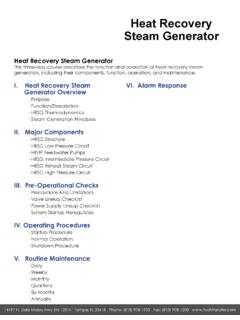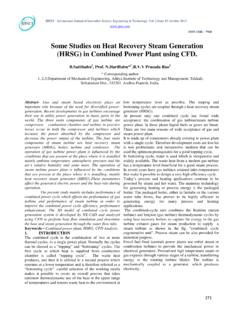Transcription of S.1 Heat Recovery Steam Generators - energy.kth.se
1 heat Recovery Steam Generators The link between the gas turbine and the Steam cycle in a combined cycle is the heat Recovery Steam Generator (HRSG). In the HRSG, heat from gas turbine exhaust is used to generate Steam in the Steam cycle. The HRSG is made up of several heat exchangers for feed water heating, water vaporization and Steam superheating, while at the same time cooling the gas turbine exhaust. There is often more than one pressure level in the Steam side of the HRSG. An Example of HRSG Source Literature Horlock, ; 1992 "Combined Power Plants" ISBN 0- 08-040502-9 Kehlhofer, R.; Warner, J.; Nielsen, H and Bachmann 1999 Combined-Cycle Gas and Steam Turbine Power Plants ISBN 0-87814-736-5 Weston, K, 1992 "Energy Conversion The EBook", ~kenneth-weston/ Acknowledgements Author: Catharina Erlich, KTH, 2005, updated 2006 2 Reviewer: Marianne Salom n, 2006 Reviewer: Vitali Fedulov, 2005 Prerequisites: At least one year of studies in an engineering program at university level; Basic Thermodynamics (at least 160 LU = 4 weeks of fulltime studies); S1B2 Steam Cycles; S1B3 Gas Turbine Cycles.
2 LU and TU Learning Units: 3 Teaching Units:1 Educational Objectives After having studied the chapter, the student should be able to: Sketch the different HRSG layouts (single pressure and dual pressure) both in a flow scheme and in a heat transfer-temperature diagram; Analyze a combined cycle thermodynamically, through heat balances in the HRSG; Understand the importance of parameters introduced for HRSG design, such as the pinch point temperature difference. Single Pressure HRSG In a single-pressure HRSG, the heat Recovery from gas turbine exhaust is normally done in three steps: In the economizer, low value heat from the exhaust gas is used for heating the pressurized feed water; In the evaporator, medium value heat from the exhaust is used for boiling the pressurized water, which generates saturated Steam ; In the superheater, high value heat from the exhaust is used for superheating the Steam generated in the evaporator.
3 EvaporatorSuperheaterCirculationpumpDrum Feed waterpumpSuperheatedSteamTo thestackGas turbineExhaustEconomizerSuperheater HRSG Flow Diagram 3 heat Transfer Diagram and heat Balances The three steps of heat Recovery in the HRSG can be illustrated in a temperature- heat transfer diagram. The aim of such a diagram is to facilitate analysis of different parameters in the HRSG. The upper line illustrates the cooling of exhaust gas from inlet to outlet in the HRSG. The lower line illustrates the water-to- Steam process, where evaporation takes place at constant temperature. The area between the exhaust profile and the water profile is a measure of the heat loss in the HRSG. An important design parameter is the pinch point temperature difference, tPP. In many HRSG designs, the feed water exiting the economizer has a somewhat lower temperature than the saturation temperature of the drum; this is called the approach temperature.
4 Different parameters of importance for analyzing the combined cycle are found through heat balances in the HRSG. TemperatureHeat transferredtg1tg2tg3 EvaporatorSuperheaterEconomizerStackGast urbineexhaustts(saturation)tshtfwtg4 tpphfwhs1hs2hsh EvaporatorSuperheaterCirculationpumpDrum Feed waterpumpSuperheatedSteamTo thestackGas turbineExhaustEconomizerSuperheatertg1tg 2tg3tg4hfwhs1hs1hs2hs2hsh Measure of heat loss in the HRSG In an ideal heat exchanger, the temperature difference between the two media on each heat exchanger side approaches zero, T 0. In a real heat exchanger, the temperature difference can never become zero, because the possible size of the heat exchanger surface area is limited. The larger the temperature difference between the two media, the lower the efficiency of the heat exchange, and thus less heat is recovered. The lower the heat Recovery (and thus efficiency), the higher the exit temperature of the cooled medium.
5 IDEAL heat EXCHANGE In the HRSG of a combined cycle, the water vaporization at constant temperature constitutes the largest heat loss. The larger the area between the exhaust profile and the water profile, the higher the exhaust temperature out from HRSG, the stack temperature. TQ heat EXCHANGE IN A HRSG Pinch point temperature difference, tPP The pinch point temperature difference ( tPP) is the difference between the temperature of the exhaust exiting the evaporator (tg3) and the temperature of water evaporation (ts): tPP = tg3 - ts 5 The water evaporation takes place at constant temperature (isothermal process) at the pressure prevailing in the drum. Without considering pressure losses in the water/ Steam tubes, the pressure in the boiler drum equals the pressure after the feedwater pump. The pinch point temperature difference, tPP , is usually between 5 C and 15 C. The lower the pinch point temperature difference, the higher the cost for the heat exchanger.
6 On the other hand, the lower the pinch point temperature difference, the more heat is recovered from the flue gas to the water-to- Steam process. The aim in introducing the pinch point temperature difference into HRSG designs is to avoid a temperature cross situation. A temperature cross situation results when part of the economizer and part of the evaporator virtually heat the EXHAUST GAS, as illustrated below. The temperature cross situation is thermodynamically impossible. TemperatureHeat transferredtg1tg2tg3 EvaporatorSuperheaterEconomizerStackGast urbineexhausttstshtfwtg4 Observe that all temperatures, tg4, tFW, tg1 and tsh, may be very reasonable. 6 The temperature cross situation can occur if the engineer assumes a stack temperature for his/her calculations without checking the pinch point temperature difference. It is thus important for all HRSG designers to always base their calculations on the pinch point temperature difference and not on the stack temperature.
7 Approach temperature The approach temperature is defined as the temperature difference between the saturation temperature and the economizer outlet temperature, tappr = ts teco,out The purpose of keeping the economizer outlet temperature somewhat lower than the saturation temperature is to avoid evaporation in the economizer. Evaporation would cause tube erosion and other problems, since most economizers are not designed to handle two-phase flows (such a heat exchanger would cost significantly more!) The approach temperature range is typically between 5 C and 12 C. heat balances in the HRSG The heat recovered from the flue gas can be balanced both from the exhaust side viewpoint and from the water profile viewpoint according to: Qrecoveredmgt cpg (tg1- tg4)mst (hsh- hfw)Gas sideSteam side (A) heat balances for each component in the HRSG are as follows (without the economizer approach temperature): Economizer: mgt cpg (tg3 tg4) = mst (hS1 hfw) (B) 7 Evaporator: mgt cpg (tg2 tg3) = mst (hS2 hS1) (C) Superheater: mgt cpg (tg1 tg2) = mst (hsh hS2) (D) Caution!
8 The specific heat , cp, is temperature dependent and thus taken as an average value between the two gas temperatures in each equation, cp for the gas passing in the economizer is NOT the same as for the gas in the superheater (for example). The enthalpies hS1 and hS2 are found in water/ Steam saturation tables for the pressure prevailing in the boiler drum. Without consideration of pressure losses, the drum pressure equals the Steam turbine inlet pressure. heat balances for each component in the HRSG with the economizer approach temperature: Economizer: mgt cpg (tg3 tg4) = mst (happr hfw) (B) Evaporator: mgt cpg (tg2 tg3) = mst (hS2 happr) (C) heat BALANCE FOR THE SUPERHEATER AND EVAPORATOR For overview calculations of a combined cycle, the gas temperature, tg2, is seldom needed. The pinch point temperature difference, on the other hand, is important to estimate, and if it is already defined, a heat balance may give other parameters of importance - for example, the Steam flow.
9 Thus, by combining equations (C) and (D), a very convenient heat balance is obtained: mgt cpg (tg1 tg3) = mst (hsh hs1) where tPP = tg3 - ts TemperatureHeat transferredtg1tg2tg3 EvaporatorSuperheaterEconomizerStackGast urbineexhaustts(saturation)tshtfwtg4 tpphfwhs1hs2hsh 8 Multi-Pressure HRSG More heat from the exhaust gas can be recovered to the Steam cycle, if several pressure levels in the Steam cycle are introduced. The increased heat exchange efficiency of a multi-pressure HRSG results in a lower stack temperature compared to a single pressure HRSG. For an HRSG with two pressure levels, the two pressures cannot be close in value; the pressure difference should be distinctive. HRSG with Two Pressure Levels If several pressure levels in the Steam cycle are introduced By introducing two pressure levels in the HRSG, the area between the exhaust profile and the water profile decreases, as illustrated in the picture to the right.
10 This area represents the heat losses in the HRSG. Hypothetically, an infinite number of pressure levels introduced on the water side would result in the heat transfer profile for water becoming a straight line. However, the efficiency increase becomes smaller 9for each new pressure level introduced. In addition, each pressure level increases the cost of the HRSG installation; therefore, introducing more than 3 pressure levels in the HRSG is seldom profitable. Lower stack temperature compared to a single pressure HRSG Example: A certain combined cycle working a certain turbine connected to a single pressure HRSG with certain Steam data (pressure and temperature) and condenser pressure has a stack exhaust temperature of 120 C. Modifying this certain cycle (same gas turbine as above) to a dual pressure HRSG, with high pressure Steam (same pressure and temperature as above) and low pressure Steam (constituting 20% of the total Steam flow - the rest is high pressure Steam ), the stack temperature of the exhaust is 80 C.











